66. Who's Knocking it out of the Ballpark?
Our panel tastes and reviews 15 made-in-Canada yellow mustards
It’s time to put the skewers down for a little while and get back to finding great, made-in-Canada products that support homegrown businesses and keep Canadian dollars in Canada, as well as avoiding higher prices on American products because of tariffs. So far we’ve covered Kosher salt and canned tomatoes.
At first glance, yellow (aka hot dog or ballpark) mustard might seem like an odd choice. After all, 42.8% of global mustard seed exports in 2023 were from Canada. And there is no shortage of great mustard makers in the country either—my research turned up at least 20 different small and independent mustardiers.1 But most of them produce what I would loosely call “fancy” or “European-inspired” mustards, often made with spicier, more pungent brown mustard seeds. When it comes to (North) American yellow mustard made from milder and tangier yellow mustard seeds, the most popular labels, like French’s and certain store-branded products, are all made in the US—often from Canadian seeds, which they use to maplewash23 their branding. Koops takes this a step further, branding the front of their labels with “The True North’s True Classic” and “Canada’s Main Squeeze,” while the back of the label tells a different story.
My research showed that in spite of this American domination of the yellow mustard market in Canada, there were in fact many Canadian yellow mustards available. Which could I use to replace the French’s and Vienna Beef yellows in my fridge? I decided that that would be my next quest.
Once I identified who made a mustard they described as “yellow,” “ballpark,” or “hot dog,” I emailed them and asked if they could send me a sample. To my surprise, almost all of them did, with a few notable exceptions.4 Perhaps watching @dailyrejection’s videos on Instagram, in which he approaches a different stranger each day with an unusual request, has helped me overcome my very strong aversion to asking for this kind of cold calling.
But it worked! And soon enough, 15 different mustards were on their way for tasting. (Not all 15 were yellow/hot dog/ballpark varieties. A bunch of makers were generous enough to send a few other varieties they thought I would also like to sample.)
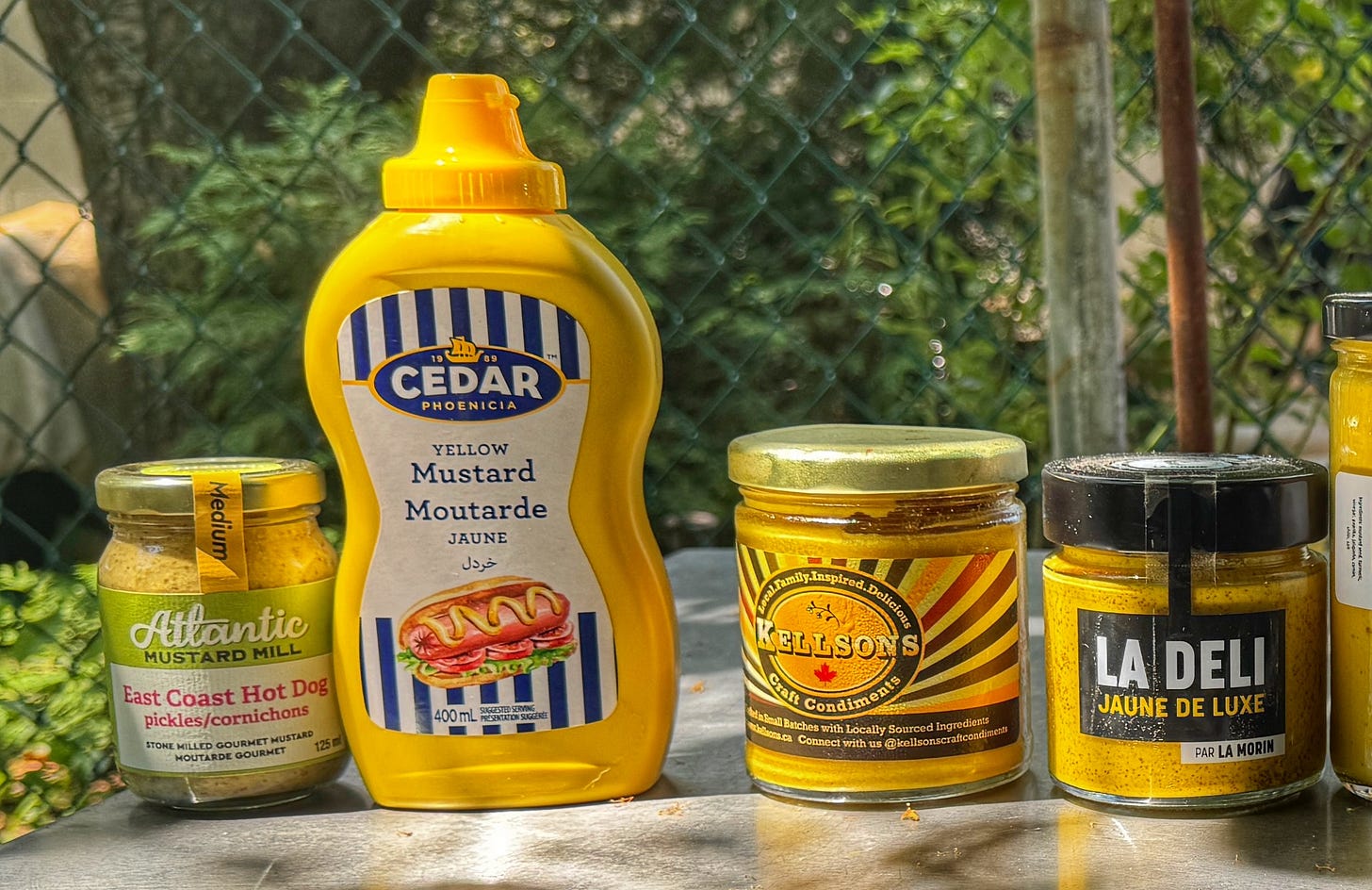
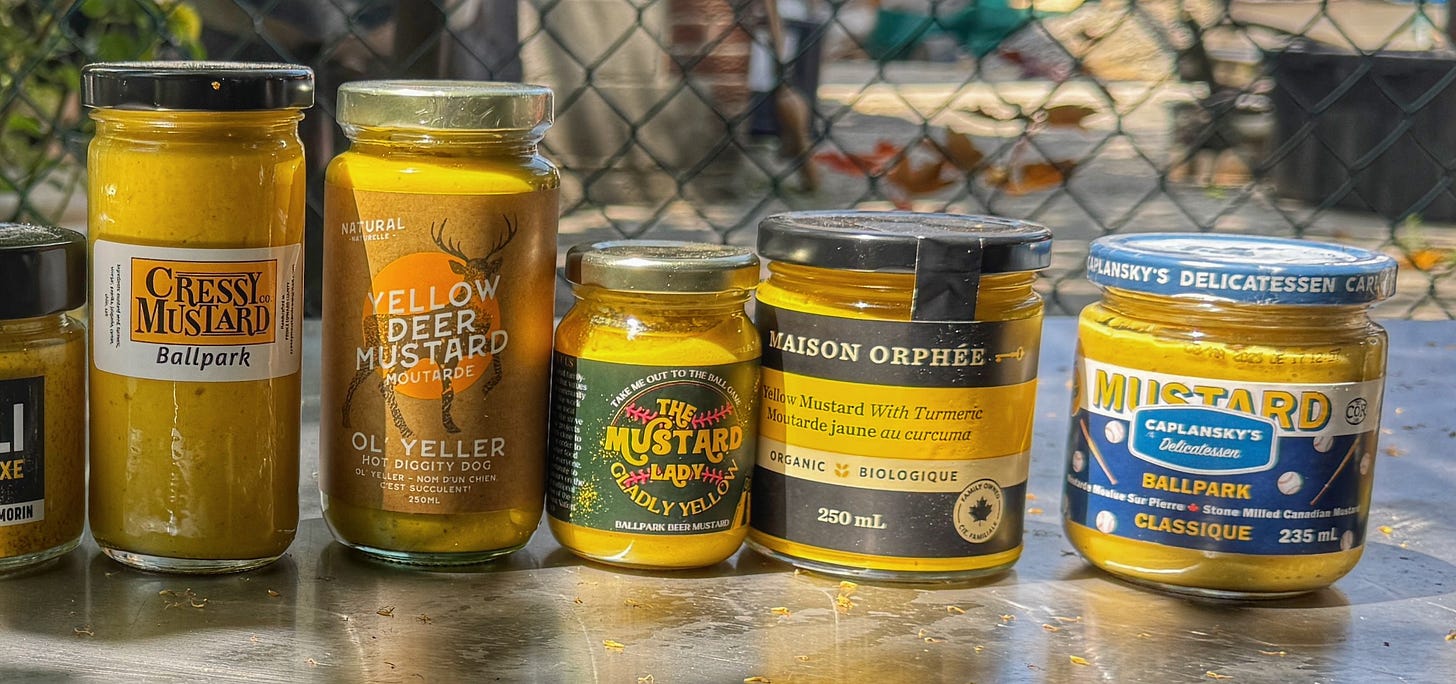
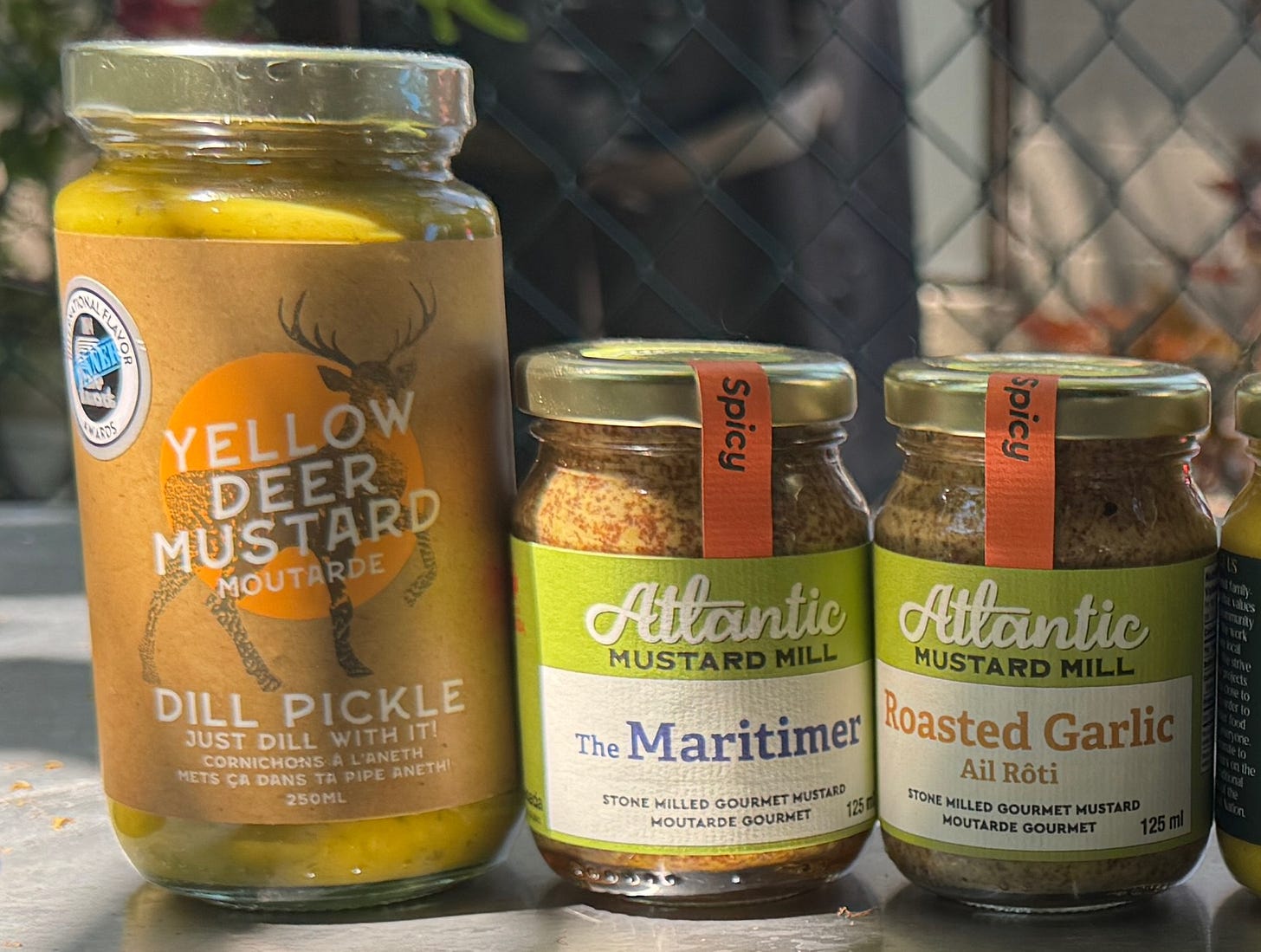
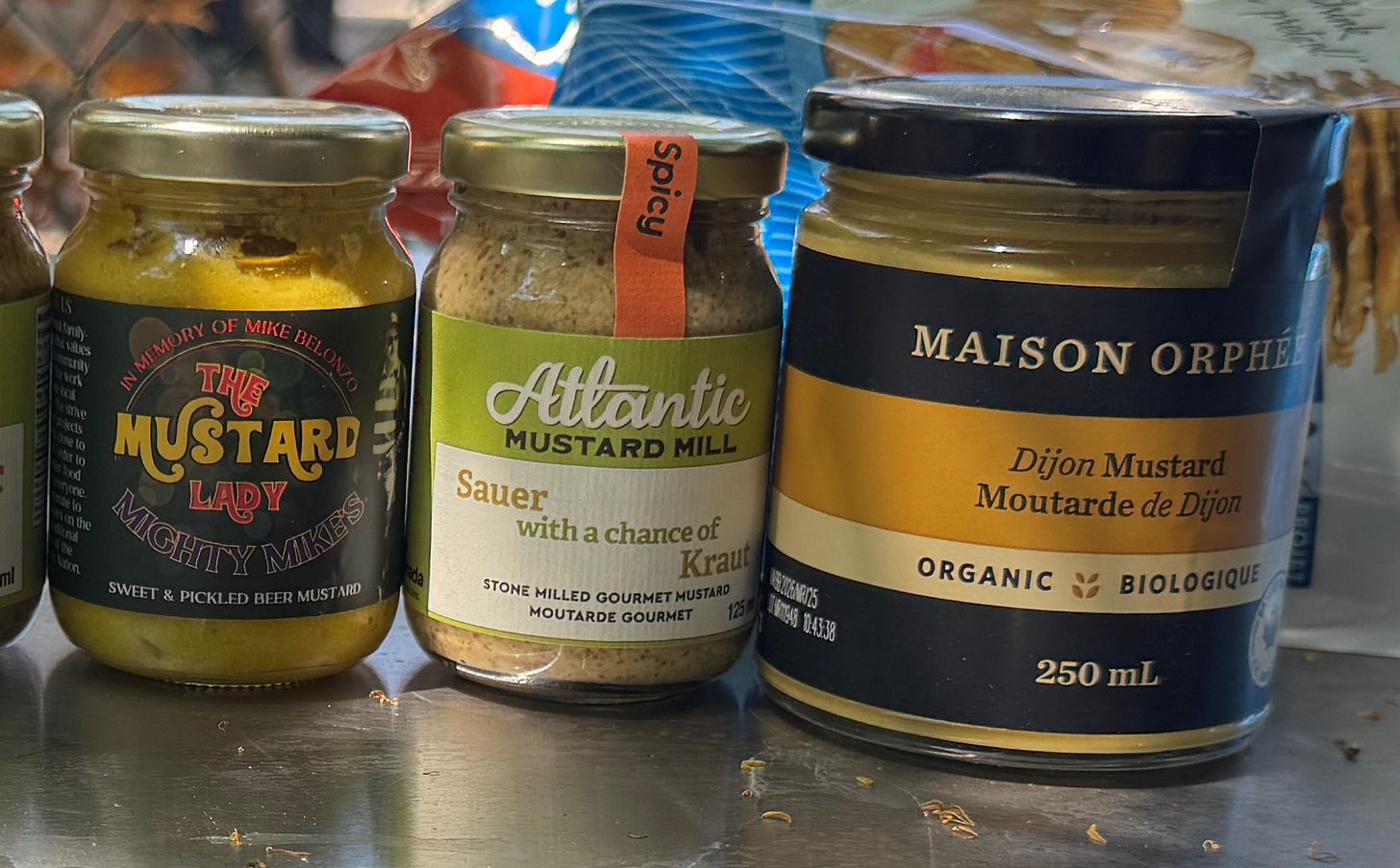
Once I had the mustards, I knew I needed some help. Not only would tasting 15 mustards by myself would be tedious and much too small a sample size, it also meant I would be left with 15 opened jars of mustard. At the best of times, our fridge is (by my doing) 50% condiments; adding 15 more jars would possibly be grounds for divorce. If I could get some help tasting and evaluating the mustards, I could also send everyone home with a few of their favourites. That’s a win for everyone except the lawyers. I put the call out to a group of 145 friends who are as excitable about food as I am. (One couple even showed up in matching mustard-coloured clothing.) Quickly, we agreed on a date for our testing.
The question then became: how to test them? Eating them from spoons seemed clinical and not very fun. Since one of yellow mustard’s names is “hot dog mustard,” the answer was right there. And, through the incredible super power of asking someone for something, I soon had a source of hot dogs lined up as well.
Sean Kwinter, who was reviving his grandfather Sam’s legendary Kwinter’s Hot Dogs just in time for the Canada Day holiday, agreed to provide his fantastic kosher, all-beef, made-in-Toronto dogs for our tasting. It had all fallen into place.
In typical Plate Cleaner timing, the tasting was scheduled for just after Canada Day; god forbid I’m organized enough to publish issues in a timely manner. Dogs were steamed (chicken for the non-beef-eaters) and sliced into bite-size bits, pretzels were put out, drinks were iced, and mustard lids were removed. Everyone had a comment sheet as well as an outline of what ChatGPT thought the Platonic ideal of a yellow mustard should be.6 It was time to taste.7
But before we get into the panel’s reactions, a few notes:
Unlike with canned tomatoes, there will be no scores in this tasting. The point was not to pit small, independent businesses against each other in some ballpark version of thunderdome. We wanted to discover what all of the great yellow mustards across the country had to offer with no winners or losers.
Speaking of winners and losers, no mustard was unanimously chosen as either good or bad.8 In reviewing the comment sheets, it was clear that different people have different preferences and very different thresholds for things like sweetness, tartness, heat, and pungency (which were very often referred to as “horseradish,” even though none of them contained it).9 What was overwhelmingly tart for some were perfectly balanced for others. Keep this and your own preferences in mind if you’re considering ordering any of them (which you absolutely should).
Several mustards received comments about having odd, unsmooth, or “oddly creamy” textures. Looking at the ingredients of the mustards that received most of those comments a common thread emerged: none of them used preservatives or stabilizers. We may have become so used to the industrially-produced default yellow mustards that we expect a silky smooth texture when, in fact, it’s more unnatural. I’ve left out most comments about texture for this reason, so if you order a mustard and it isn’t the consistency of French’s, don’t be surprised.
On to the tasting
As I see (and taste) it, the 15 mustards could be divided into 3 groups:
Yellow or Almost Yellow (listed in alphabetical order)
These are mustards that are the closest one-to-one substitutes for standard yellow mustards, although they are almost all an improvement. Tartness and pungency vary, but there is certainly a variety to please almost anyone.
Caplansky’s Ballpark - (Full disclosure: I’ve known Zane for many years, having worked on ads for his deli when it was launching on College St. In fact, Beth and I had our wedding there.) From being a pop-up sandwich maker to the owner of multiple delicatessen locations to mustard impresario, Zane Caplansky has been pleasing palates for nearly 20 years.
Tasters described Caplansky’s as “classic” and “a split between a smooth Dijon and a ballpark.” In fact, its smooth consistency, which one taster said was “creamy” was noted by several tasters, as was its balanced acidity. Perhaps swayed by Caplansky’s history, one taster noted it would taste best on a smoked meat sandwich. I found it slightly tarter than the others in this group, which for my palate is a good thing.
Cedar is the house brand of the Marché Adonis supermarket chain and the only house brand I could find that was made in Canada. They’re best known for other products like olive oil, dried and canned beans, and dairy products, not their mustard. This is because, to put it plainly, it’s not very good. Only one taster wrote that they liked it. The most common comment was “meh.” The must unexpected: “tastes a little bit of foot.”10
Cressy Mustard Co.’s Ballpark Mustard
Based in Waupoos, Prince Edward County, Ontario, Cressy Mustard was first made by Sarah Harrison to sell to raise money for the Cressy Church. It was such a hit that it became a business, with eight varieties of mustard now available.
Cressy’s twist is the inclusion of smoked paprika and cumin in addition to the standard turmeric. Tasters called it “a great all-round mustard” with “good classic flavour” that “still has bite”. Slightly tart and slightly spicy (perhaps from the paprika), it divided people who either really enjoyed those qualities or weren’t as into them. Again, govern yourself accordingly.
Kellson’s Classic Yellow Mustard
When Travis Kell replied to my inquiry, he gave me a quick mustard history lesson, explaining that the origins of American mustard traditions first came from Germans who migrated to the Carolinas, which is why Carolinian-style barbecue sauces are often very mustard heavy. He also noted that his uses mustard milled by G.S Dunn Dry Mustard Millers, who have been milling mustard in Hamilton, Ontario since 1875 and are the largest miller of its kind in the world.
Made with all natural ingredients and no stabilizers, many tasters flagged Kellson’s as a classic example of the ballpark style, with a mild bite and good acidity. Others enjoyed the thick, smooth consistency. Another taster thought its brightness and clean finish “would be perfect in a mustard-forward potato salad.” I found it had a nicely mild flavour that balanced well with the medium spice of the Kwinter’s dog11 without overwhelming it.
Maison Orphée’s Yellow mustard with Turmeric
Founded in Quebec in 1983 and now a certified B-Corp run by sisters Élisabeth and Élaine Bélanger, Maison Orphée has products including oils, vinegars, mustards, mayonnaises, and vinaigrettes in over 2,000 retailers across Canada, so you’re likely to have run into one of them at some point.
Many tasters noted the strong (organic) apple cider vinegar flavours to this mustard, again to varying degrees of enjoyment. Some thought it would be “great for hot dogs,” “good for salad,” or “I’m thinking about a homemade mac and cheese.” There was also a hint of fermented funk which, again, is something you might be into. It wasn’t for everyone, but some people definitely stood by it.
Yellow Deer Mustard’s Ol’ Yeller
Mustard from the east coast of Vancouver Island, specifically Qualicum Beach, B.C. Yellow Deer prides itself on handmaking its mustards using Canadian-grown mustard seeds and, mostly, free of additives and preservatives.
Yellow Deer calls Ol’ Yeller “a mellow gourmet yellow” with a unique blend of spices including celery seed. It was another popular choice among our tasters, who noted its brightness, tang, and acidity. It was called “smooth and deep” and “classic yellow.” My notes say, “Dimensions. Good complexity.” Perhaps I was picking up on the celery seed? As Yellow Deer promised, it was definitely a yellow mustard but it also brought a little more, which people liked.
Ballpark-Adjacent
These mustards had some characteristics that brought them close to being a classic ballpark, but, at the same time, had other characteristics were not part of the ballpark orthodoxy. These often got comments about how they weren’t a true ballpark mustard.
Atlantic Mustard Mill’s East Coast Hot Dog Mustard
Sabine and Michael Schoenknecht founded Atlantic Mustard Mill in Murray Harbour North, Prince Edward Island in 2018, having first moving from Germany to PEI in 2013. Along with pickles, sauces, and dressings, they produce over 45 different varieties of mustard.
The Schoenknecht’s don’t produce a classic yellow mustard, but this one had the words “hot dog” in the name (and properly spelled as two words) so it was close enough for me. It combines both yellow and brown seeds with homemade pickles, savory, and dill for a flavour that was a favourite for many tasters.12 Though some grumbled that it wasn’t a classic ballpark mustard, its medium pungency and strong pickle flavour were big hits. As well as noting that it worked well with the Kwinter’s dogs, tasters also thought it was “screaming for a roast beef sandwich,” and would be great in potato salad.
La Morin’s La Deli Jaune De Luxe
Based in Montreal, Julien Morin was inspired by his grandfather’s quest for the perfect mustard “that tickles your nostrils and leaves you with a strong, everlasting impression.” Mission accomplished, Julien! This bright yellow example certainly packed the most punch of any mustard at the tasting, which was either perfect or overwhelming, depending on the taster. But those who liked it were very enthusiastic.
Calling it “La Deli” as instead of “La Stade” or “Le Parc” is the right decision, as its flavour definitely evokes a deli more than a stadium. One taster described it as “for real mustard fans” and several wanted to try it on sandwiches, particularly roast beef. Not for the faint of heart, but definitely for heat enthusiasts.
The Mustard Lady’s Gladly Yellow
The Mustard Lady is a small, family-run company in Courtenay BC, in the Comox Valley, also on the east coast of Vancouver Island.13 Strongly community-minded, they offer their products alongside other products made by other local farmers and makers. At their shop they also offer cheese and charcuterie boards and preserves.
What most distinguishes Gladly Yellow from the other ballpark14 mustards is right in its description on the label: Ball Park Beer Mustard. The beer flavour, from an IPA from the Gladstone Brewing Co, is front and centre and adds a dimension that the other ballparks didn’t have. I think because of the unexpectedness of the beer flavour, some found it a little confusing, but one taster called it “oddly satisfying.” I found that after my initial confusion, I liked how the beer complemented the beefy flavour of the Kwinter’s hot dog I had for lunch today, when an actual beer wasn’t available to do the job.
Other Flavours
Atlantic Mustard Mill’s Roasted Garlic — This was one mustard that produced two different reactions. The strong roasted garlic flavour of this gold medal winner at the 2025 World Mustard Competition was intense and tasty for some but overwhelming for others. If you’re into deep garlic flavour, this might be a good choice for you.
Atlantic Mustard Mill’s The Maritimer — Fermented and built for maximum heat, this was one of the mustards often described as “horseradish,” which, again, I understand to mean “heat and pungency.” That strength was appreciated by many, who wanted to try it on sandwiches or, for one taster, a croque monsieur. If there were a “Big Punchers” category, The Maritimer and La Morin’s La Deli would be in it.
Atlantic Mustard Mill’s Sauer with a chance of Kraut — Made with sauerkraut using an old recipe from Sabine’s family, people appreciated the bright tartness of the mustard. Once again, it really depended on how the taster felt about sauerkraut in general. A great choice for kraut lovers.15 (Overheard but not written down, “This is the kind of name more mustards should have! It’s so fun.)
Being a Dijon, of course, our tasters were much more familiar with what to expect than with the other non-ballparks. And, by and large, they thought it was a good representation of the form, noting its nice “horseradish” bite, its moderate acidity, and its smoothness. One taster noted, “I want to use it as a face mask. Wow!” Overall, an excellent option if you are looking to replace your French Dijon16 with a homegrown product instead.
The Mustard Lady’s Mighty Mike’s
Named after the late father of the Mustard Lady’s best friend, a portion of every jar of Mighty Mike’s is donated to cancer research and those affected by cancer. The label bills it as “sweet & pickled beer mustard” and our tasters definitely agreed, with almost every comment noting its sweetness. One comment said the sweetness made it “great mustard for non-mustard lovers.” To another, the sweetness would “make a nice salad dressing or marinade for honey mustard salmon,” which seems appropriate for the coast of Vancouver Island. Others picked up on the pickle-y tanginess, which some described as “bread and butter pickle” or “relish.” And others, perhaps noting the Gladstone Brewing IPA in it, said it, “needs a good brat,” or, “would be good on an Oktoberfest sausage.”
Yellow Deer Mustard’s Dill Pickle
Containing chunks of dill pickle, dill weed, and dill seed, this one was definitely dill forward, as noted by several tasters, who found the turmeric prominent as well. Some tasters observed that the consistency was slightly looser than others.17 Again, that’s what some are looking for and some are not. My favourite comment was, “Mustard AND relish! Love it.”
This issue is long enough, so we will return to “What I’m consuming…” and “What’s on the menu…” next time.
For now, so many thanks to the mustard makers and to Kwinter’s for providing all of our samples and dogs, to the great panel of participants18 who gave up part of their Sunday to argue about mustard, and to all who are reading this. If there’s another product you’d like me to find a great made-in-Canada version of, drop me a line or let me know in the comments.
My research was not just going on Reddit, I’ll have you know. I searched on Google, too.
Maplewashing: The practice of using the most tenuous of connections to Canada as an excuse to slap a deceptive maple leaf on a product’s packaging.
I bet this company regrets choosing the name it did.
Cough, cough, Kozlik’s and Firebarns.
Also, admittedly, an unscientifically small sample size as well, but 14 times better than if was when it was just me.
This was hotly debated even before any tasting began.
Again in the spirit of honesty, (honesty that some might see as buried in a footnote, but nevertheless, here it is) during the tasting I was preoccupied with keeping things running as smoothly as possible, so I didn’t take a lot of time to appreciate the quality of the Kwinter’s dogs, which were great, and my tasting notes for the mustards are either sparse or illegible. Today I took a moment at lunch to give some of the mustards a fairer taste, as well as eating a good amount of the hot dog plain so I could appreciate it as well. And appreciate it I did. Perfect texture. Great medium spice. Not as aggressively garlicky as some, which I appreciate more and more. I have a new go-to.
Although one came very, very close.
I blame fake wasabi for this. Real wasabi is a kind of horseradish, but the imitation stuff you almost always get with sushi is a mix of horseradish and mustard, which is much cheaper. The intense pungency people associate with horseradish is actually mustard.
From context clues, I was able to figure out that “foot” was an undesirable flavour. (You never know.)
I love the dogs, Sean, but can we talk about a natural casing version as well?
Including me! When we were divvying up the jars at the end of the tasting, I squirrelled this one away so it wouldn’t get snapped up by someone else. This mustard on a Kwinter’s dog is a perfect match.
Just a 40-minute drive from Qualicum Beach. It’s nice to see that there aren’t any mustard turf wars considering the proximity.
Or ball park. I’m much less invested in whether it’s one word or two.
And makers, like me!
Or replace a domestic Dijon made by a mustardier who never replied to your emails about taking part in this tasting, Anton.
Making it almost more of a mustard pickle than a pickle mustard?
If you’re interested in being on a future tasting panel, let me know!



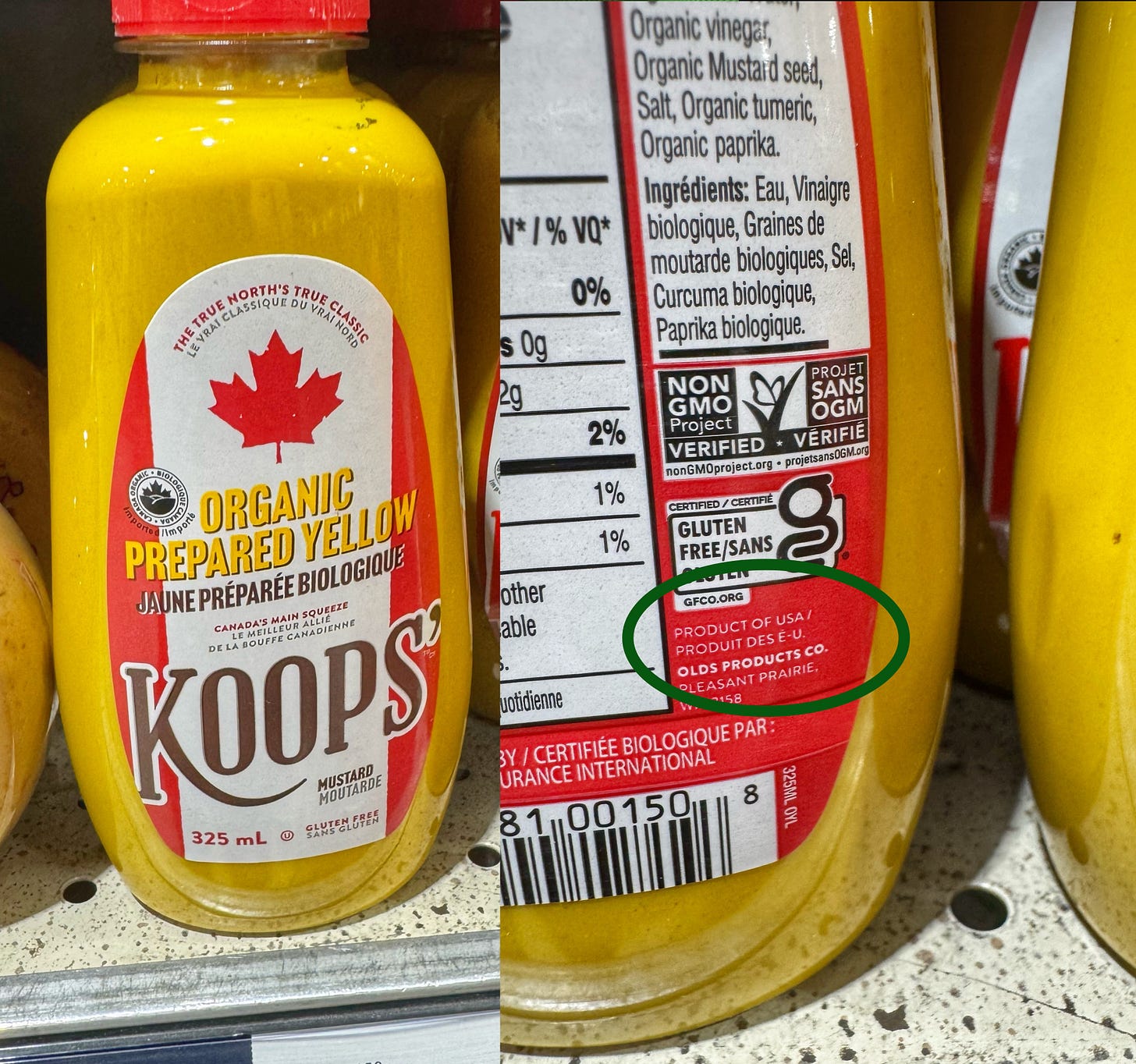


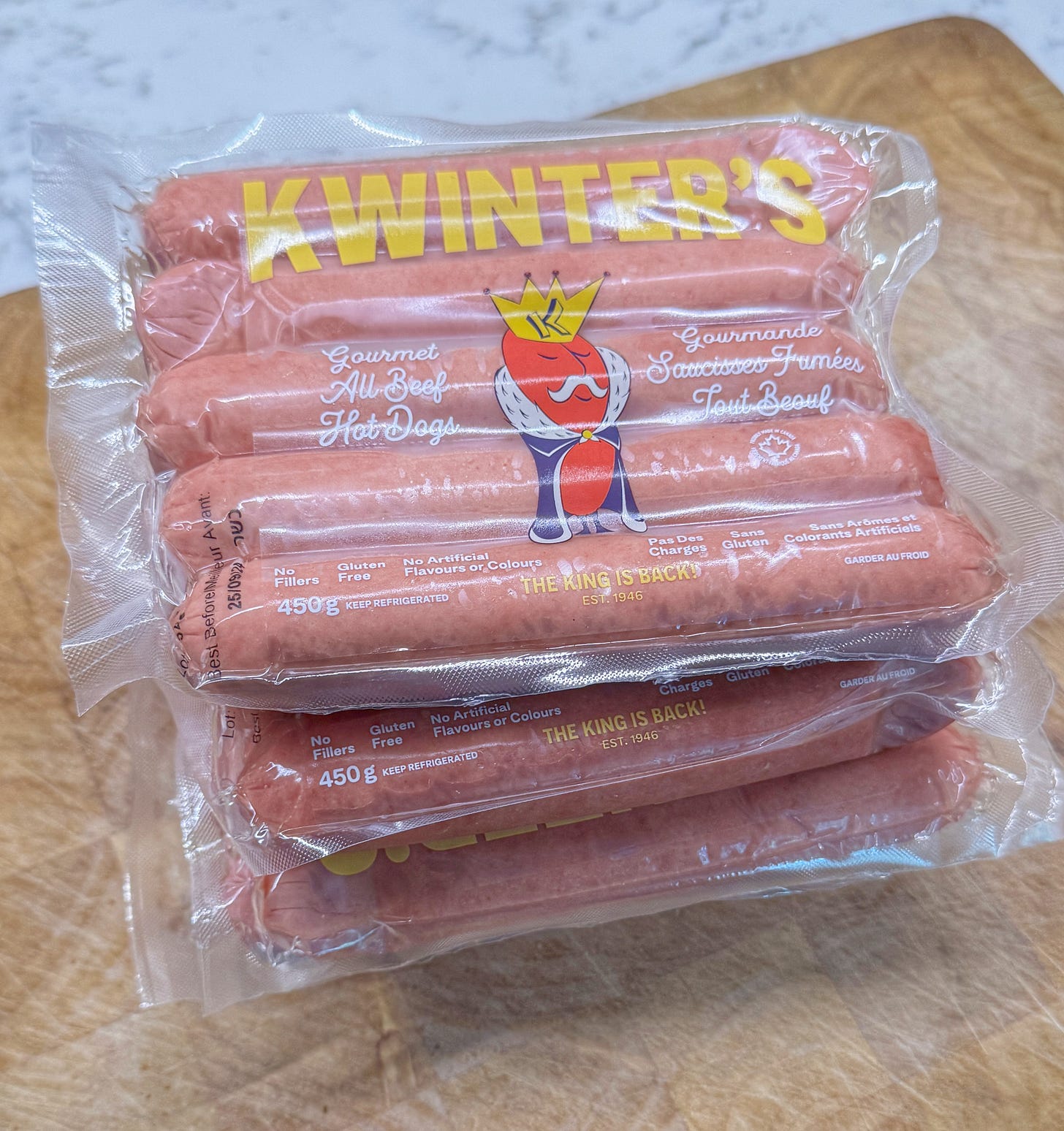


I am apologetically sorry I missed this event. My penance, if I am ever invited to another, is to take on cooking or cleaning duties!! What a great and informative read! I am becoming accustomed to searching my emails for the ‘next’ Plate Cleaner!!!
This making me wonder if someone makes a mustard combined with chow chow.